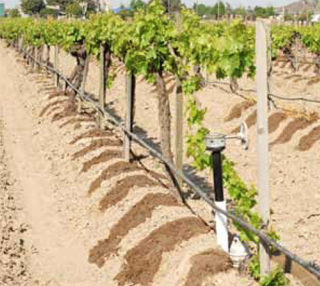USDA secretary Tom Vilsack has announced the agency will invest $400 million with at least 18 irrigation districts, including five in California, to help farmers continue commodity production while also conserving water across the West.
The funding, which will support irrigation districts and producers using innovative water savings technologies and farming practices while producing water-saving commodities in the face of continued drought, is expected to conserve up to 50,000 acre-feet in water use across 250,000 acres of irrigated land in production, while expanding and creating new, sustainable market opportunities.
“Agricultural producers are the backbone of rural communities across the West and many of them are struggling under prolonged drought conditions,” Vilsack said. “USDA is taking an ‘all hands’ approach to help address this challenge, including these new partnerships with irrigation districts to support producers. We want to scale up the tools available to keep farmers farming, while also voluntarily conserving water and expanding markets for water-saving commodities.”
USDA worked to select irrigation districts based on several commodity production and water management-related criteria in order to maximize the ability to achieve program objectives, leveraging available data from the Department of the Interior’s Bureau of Reclamation to ensure close alignment and partnership. USDA’s Economic Research Service (ERS) provided data and analysis to support the preliminary selections. Districts that have been preliminarily selected for potential inclusion in this program include:
- Black Canyon Irrigation District, Idaho
- Brooklyn Canal Company, Utah
- Central Oregon Irrigation District, Ore.
- Central Arizona Irrigation and Drainage District, Ariz.
- Corcoran Irrigation District, Calif.
- East Columbia Basin Irrigation District, Wash.
- Elephant Butte Irrigation District, N.M.
- Glenn – Colusa Irrigation District, Calif.
- Greybull Valley Irrigation District, Wyo.
- Hidalgo & Cameron Counties Irrigation District 9, Texas
- Huntley Project Irrigation District, Mont.
- Imperial Irrigation District, Calif.
- Maricopa – Stanfield Irrigation and Drainage District, Ariz.
- Palisade Irrigation District, Colo.
- Quincy Columbia Basin Irrigation District, Wash.
- Solano Irrigation District, Calif.
- Sutter Mutual Water Company, Calif.
- Truckee-Carson Irrigation District, Nev.
The preliminarily-selected districts may receive up to $15 million each in the awards and will enter into sub-agreements with producers participating within the district. Depending on available funding, awards to additional districts may be possible.
Producers who participate will receive payments for voluntarily reducing water consumption while maintaining commodity production. The needs of producers will determine the specific strategies for water conservation, including irrigation improvements, shifts in management practices, shifts in cropping systems, and other innovative strategies. USDA will learn from the diversity of strategies used and identify additional opportunities to maintain and expand water-saving commodity production in the future.
Participating producers and irrigation districts will commit to ensuring continued commodity production in the areas where water consumption is reduced. USDA is working to finalize agreements with the preliminarily selected districts, which will include the details of each individual district’s water-saving strategies, commodities to be produced, and specific budgets. Following the finalization of those awards, producers within the participating districts will work directly through their irrigation districts to participate. USDA and the preliminarily-selected districts will provide more details on the agreements and opportunities for producers to directly enroll.



